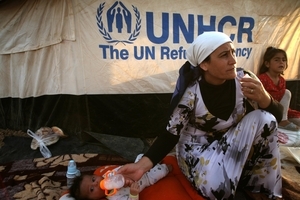
The U.N. refugee agency has announced that the refugees fleeing the Syrian conflict have surpassed 2 million (Photo Credit: Safin Hamed/AFP/Getty Images).
By Charlotte Phillips, Amnesty International’s Researcher on Refugee and Migrants’ Rights
It is difficult not to feel overwhelmed by the scale and brutality of the conflict in Syria, the massive displacement and deep suffering it is causing countless human beings.
António Guterres, the U.N. High Commissioner for Refugees, has described the Syrian conflict as “the great tragedy of this century – a disgraceful humanitarian calamity with suffering and displacement unparalleled in recent history.”
This situation has deteriorated rapidly in recent weeks after videos emerged showing scores of civilians apparently killed by chemical weapons in towns outside Damascus.
In the past 24 hours, the United Nations has announced that the number of refugees from Syria has officially reached 2 million, a tragic milestone. At least 1 million are children, many under the age of 11. But as with all statistics, this only tells us part of the story because behind every number is the human story of someone who has experienced extraordinary loss.
The United Nations has announced that the number of refugees from Syria has officially reached 2 million, a tragic milestone. At least 1 million are children, many under the age of 11.
Because, after all the pain and suffering that people have endured in Syria, the reality is that life is extremely hard for refugees in the neighboring countries.
My colleagues and I recently returned from Za’atri refugee camp in Jordan, now the second-largest refugee camp in the world after Kenya’s sprawling Dadaab camp. It has unofficially become Jordan’s fourth-largest city. It currently hosts almost 130,000 refugees from Syria with significant numbers of children and vulnerable individuals, some who have survived torture, are seriously injured or sick, are elderly or have disabilities.
The U.N. and organizations working on the ground have made a number of appeals to the international community for funding – because, despite some significant donations, essential services such as food assistance, education, a more reliable water supply system and shelter continue to be seriously underfunded. And it is not just Za’atri or indeed Jordan, where there is a shortfall in funding to protect and assist refugees.
The same is true across the region where refugees, particularly in community settings, are struggling to access services, and host countries are buckling under the strain. All these host countries are facing significant economic and political challenges due to the influx – the increased pressure on local services, meanwhile, is exacerbating tensions between refugees and local communities.
So, as many people have asked in recent days and months, what can be done?
With no political solution in sight for Syria, the very least that can be done is to allow those who have escaped with their lives to live in safety and dignity. The U.N. estimates that almost $3 billion is currently needed for it to meet the needs of refugees in the region and, in June, launched the largest humanitarian appeal in its history.
To date, the United States, Kuwait and the European Commission have been among the largest donors. But despite this, the appeal is currently only 40 percent funded. Countries with the means to do so – European countries, North America, the Gulf states and elsewhere, must continue to scale up their funding to the refugee crisis and should plan to provide sustained, long-term support to Syria’s neighbors.
But this alone will not alleviate the refugee crisis. Donor governments should be prepared to take the most vulnerable refugees out of the region and allow them to settle safely in their countries, via resettlement and humanitarian admission programs. As well as providing a very real lifeline for the most vulnerable, this will help to alleviate some of the burden being borne by Syria’s neighbors.
While Germany has so far agreed to take 5,000 Syrian refugees via a humanitarian admission program, the response from other countries has been more limited to date.
If you live in a country that could and should do more for the people of Syria, then now is the time to call on your government to increase their support for refugees from Syria. There has been a lot of talk in recent weeks about what the international community should or shouldn’t do in relation to the Syria conflict. Supporting the refugees is unquestionably something they can do, and must do to a far greater extent.